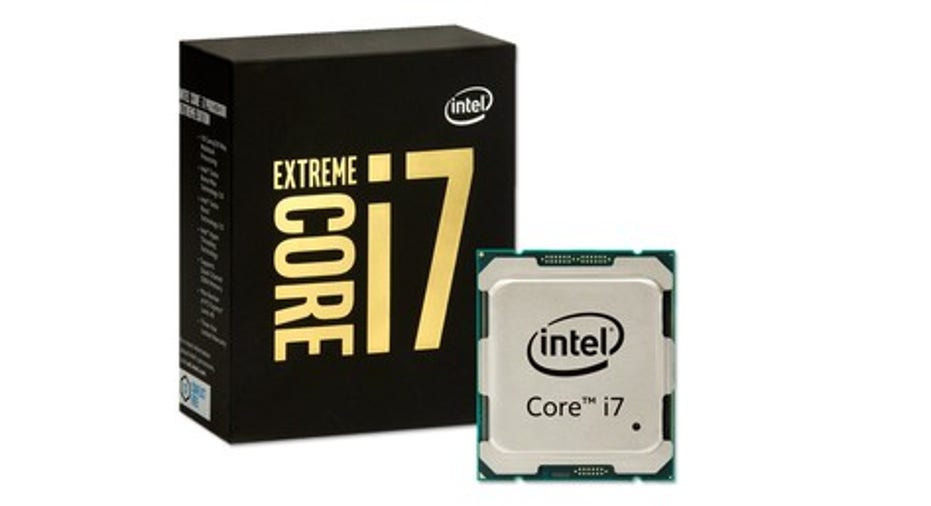Who Will Buy Intel Corporation's $1,700 Desktop CPUs?

Intel recently unveiled its first 10-core desktop CPU, the Intel Core i7-6950X Extreme Edition. The new processor runs at 3GHz (with boost speeds of up to 3.5GHz), has 25MB of cache, 40 PCI Express 3.0 lanes, and features Intel's new Turbo Boost 3.0 technology.
Intel claims those specs make it twice as fast as its top-tier quad-core i7 6700K for 3D rendering and 65% faster at editing 4K video. But customers will pay a lot for that performance boost -- the 10-core i7-6950X will cost a whopping $1,723, roughly five times the price of the i7 6700K. So who is Intel actually targeting with such a pricey processor?
Image source: Intel.
Intel says it's for gamers
In its press release, Intel declares that the "growing community of more than 1.3 billion" gamers "are continually raising the bar" by "driving their systems to its limits." The company also says that the 10-core CPU delivers "a fantastic experience" with virtual reality headsets like Facebook's Oculus Rift and HTC's Vive.
But for most gamers, buying a $1,700 processor is complete overkill. Simply take a look at the recommended specs for two graphically demanding current-gen games -- Square Enix's Rise of the Tomb Raider and Electronic Arts' Star Wars Battlefront.
Rise of the Tomb Raider's recommended requirements include a Core i5-750 2.4GHz CPU ($150), Nvidia's GeForce GTX 970($300), and 16GB of RAM. Battlefront's recommended requirements includea Core i5-6600 3.3 GHz ($230), a GeForce GTX 970, and 16GB of RAM. Most modern games rely more on the GPU and the amount of available RAM instead of the processor, so spending $1,700 on a 10-core CPU for gaming seems pretty wasteful.
Rise of the Tomb Raider. Image source: Square Enix.
Meanwhile, prices for high-end graphics boards are rapidly dropping. Nvidia's new GTX 1070, for example, costs $380 andoffers better performance than its top-tier Titan X, which costs around $1,000. PC Gamer's recent guide for building a high-end gaming PC noted that all the necessary components could be bought for around $2,000. As for virtual reality, "VR ready" PCs generally cost around $1,000. Lastly, a recent Valve survey found that less than20% of gamers plan to upgrade their current systems to play VR games -- which greatly limits the total addressable market of a 10-core desktop CPU.
It's really all about Moore's Law
Intel's launch of a pricey niche CPU doesn't really make sense in the context of gaming, but it makes sense in the context of Moore's Law's coming undone. That "law" claimed that the number of transistors within the same area of silicon can double every two years, and served as the foundation of Intel's "tick-tock" strategy for decades.
During a "tick" launch, Intel introduces a smaller microarchitecture with a new manufacturing process. During a "tock" launch, the microprocessors are upgraded but the die size remains the same. In the past, the tick-tock cycle was about two years long. But over the past few years, it became increasingly expensive and difficult to engineer smaller chips. In March, Intel announced that it would officially replace the 24-month tick-tock cycle with a 30-month "process, architecture, and optimization" model.
Simply put, Intel couldn't keep boosting clock speeds and keep shrinking down its chips as quickly as before, so it resorted to a cheaper way of boosting performance -- adding additional CPU cores to existing architecture. In addition to a 10-core CPU, Intel is launching six- and eight-core CPUs based on the same Broadwell-E architecture. A notable drawback of Broadwell-E is that clock speeds gradually decline as more cores are added, so Intel added the Turbo Boost feature to compensate. But Ars Technica's Andrew Cunningham recently pointed out that for single-threaded tasks, "a faster CPU with fewer cores may well beat your new 10-core, $1,700 monster."
Is Intel just trying to generate media buzz?
Intel likely knows that it won't sell many 10-core desktop CPUs. But it also likely knows that announcing a "10-core" processor would generate free publicity about its processors and potentially counter the notion that its CPU upgrades weren't that dramatic anymore. It's not all that different from IBM's claimof creating the world's tiniest CPU with 7nm technology last year. That announcement initially stunned Intel investors, but it quickly became apparent that Big Blue's chip would be too costly to mass produce.
Intel also can't sidestep the slowdown in PC sales by relying on gamers, as Nvidia did, because high-end gaming relies more on add-in graphic boards than multi-core CPUs. Therefore, Intel's new six, eight, and ten-core CPUs probably won't move the needle for its Client Computing Group, which posteda 2% annual sales decline last quarter. But they represent interesting technical milestones, which might appeal to a niche group of desktop PC enthusiasts.
The article Who Will Buy Intel Corporation's $1,700 Desktop CPUs? originally appeared on Fool.com.
Leo Sun has no position in any stocks mentioned. The Motley Fool owns shares of and recommends Facebook and Nvidia. The Motley Fool recommends Intel. Try any of our Foolish newsletter services free for 30 days. We Fools may not all hold the same opinions, but we all believe that considering a diverse range of insights makes us better investors. The Motley Fool has a disclosure policy.
Copyright 1995 - 2016 The Motley Fool, LLC. All rights reserved. The Motley Fool has a disclosure policy.